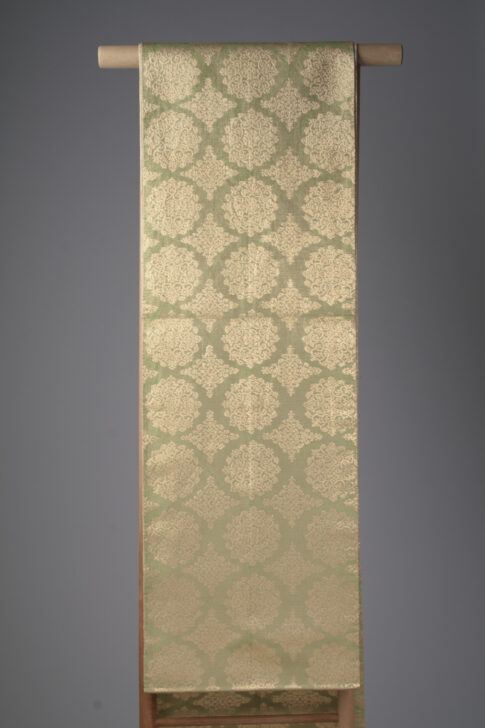Saga nishiki style brocade reversible fukuro obi; one side with woven gold medallions on lime green; the other with woven gold medallions on white
Japanese

Description
Saga brocade reversible "fukuro obi": one side with woven gold medallions on lime greem; the other with woven gold medallions on white
---
Obi
Japan, Showa period (1926–1989)
1960s–70s
Green silk with gold embroidered design
Gift of Howard and Patricia Yamaguchi, 2005/1.342
Obi
Japan, Showa period (1926–1989)
1970s
Ivory sateen weave silk with large woven designs in gold-leafed paper
Gift of Howard and Patricia Yamaguchi, 2005/1.328
Obi
Japan, Showa period (1926–1989)
1950s–60s
Red silk with woven and embroidered design and gold-wrapped thread
Gift of Howard and Patricia Yamaguchi, 2005/1.344
Obi
Japan, Showa period (1926–1989)
mid-20th century
Black silk interwoven with silk floss and gold-covered paper threads
Gift of Howard and Patricia Yamaguchi, 2005/1.345
Obi*
Japan, Showa period (1926–1989)
1940s–60s
Brocade with patterns in silk floss and gold-leafed paper
Gift of Howard and Patricia Yamaguchi, 2005/1.329
These five gorgeous obi, all made of brocade, are intended to be worn with and complement formal kimono, such
as the black tomesode and gray hômongi on the right. The red obi with a pattern of medallions against gold wavy lines was worn with long-sleeved kimono (called furisode, meaning “swinging sleeves”). Such kimono are worn only by unmarried women until their twenties; this one was worn by Iwata Shizuka’s daughter, Shizuko. The use of red as a dominant color, whether on kimono or obi, is also limited to young, unmarried women or brides at their wedding.
The Nishijin area of the city of Kyoto has dominated the production of the high-quality woven textiles used for obi since the fifteenth century. The weaving industry flourished there under the protection and encouragement of the flamboyant military rulers of the Azuchi-Momoyama period (1568–1615), Oda Nobunaga (1534–1582) and Toyotomi Hideyoshi (1536–1598). The production of Nishijin textiles is very complex and specialized in five main areas—designing and creating patterns, producing silk threads, producing tools (including weaving machines), weaving, and final sewing—each accomplished in a different workshop.
*Pictured obi
(Wrapped in Silk & Gold Exhibition, Summer 2010)
Subject Matter:
Saga brocade is among the most expensive fabrics. Paper wrapper reads: Haha yori (from mother)
Physical Description:
Reversible brocade obi with medallion patterns in gold-leafed paper (kinran) and pale yellow silk floss.
Usage Rights:
If you are interested in using an image for a publication, please visit https://umma.umich.edu/request-image/ for more information and to fill out the online Image Rights and Reproductions Request Form.